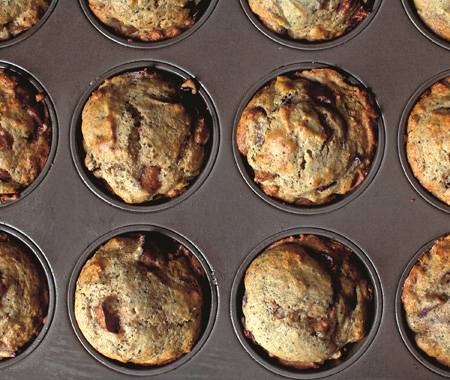Recipe
January 4, 2013
Plum Poppy Seed Muffins Recipe

Step 1: Preheat your oven to 375°F. Butter twelve muffin cups.
Step 2: Whisk the egg with both sugars in the bottom of a large bowl. Stir in the melted butter, then the sour cream. In a separate bowl, mix together the flours, baking powder, baking soda, salt, cinnamon, nutmeg and poppy seeds, and then stir them into the sour cream mixture until it is just combined and still a bit lumpy. Fold in the plums.
Step 3: Divide batter among prepared muffin cups. Bake for 15-18 minutes, until the tops are golden and a tester inserted into the centre of a muffin comes out clean. Rest muffins in the pan on a cooling rack for 2 minutes, then remove them from the tin to cool them completely.
Do Ahead: Generally, I think muffins are best on the first day, but these surprise me by being twice as moist, with even more developed flavours, on day two. They’re just a little less crisp on top after being in an airtight container overnight.
Note: I’ve learned that you can dial back the sugar in most recipes quite a bit and not miss much (though, if you find that you do, a dusting of powdered sugar or a powdered-sugar-lemon-juice glaze works well here). I also learned that a little whole wheat flour goes a long way to keep muffins squarely in the breakfast department; that you can almost always replace sour cream with buttermilk or yogurt, but I like sour cream best. Thick batters — batters almost like cookie dough — keep fruit from sinking, and the best muffins have more fruit inside than seems, well, seemly. And, finally, in almost any muffin recipe, olive oil can replace butter, but people like you more when you use butter — and if you brown that butter first, you might have trouble getting them to leave.
See more recipes from Deb Perelman.
Reprinted with permission from Deb Perelman’s The Smitten Kitchen Cookbook (2012 Appetite by Random House).
Directions
Yield:
Step 1: Preheat your oven to 375°F. Butter twelve muffin cups.
Step 2: Whisk the egg with both sugars in the bottom of a large bowl. Stir in the melted butter, then the sour cream. In a separate bowl, mix together the flours, baking powder, baking soda, salt, cinnamon, nutmeg and poppy seeds, and then stir them into the sour cream mixture until it is just combined and still a bit lumpy. Fold in the plums.
Step 3: Divide batter among prepared muffin cups. Bake for 15-18 minutes, until the tops are golden and a tester inserted into the centre of a muffin comes out clean. Rest muffins in the pan on a cooling rack for 2 minutes, then remove them from the tin to cool them completely.
Do Ahead: Generally, I think muffins are best on the first day, but these surprise me by being twice as moist, with even more developed flavours, on day two. They’re just a little less crisp on top after being in an airtight container overnight.
Note: I’ve learned that you can dial back the sugar in most recipes quite a bit and not miss much (though, if you find that you do, a dusting of powdered sugar or a powdered-sugar-lemon-juice glaze works well here). I also learned that a little whole wheat flour goes a long way to keep muffins squarely in the breakfast department; that you can almost always replace sour cream with buttermilk or yogurt, but I like sour cream best. Thick batters — batters almost like cookie dough — keep fruit from sinking, and the best muffins have more fruit inside than seems, well, seemly. And, finally, in almost any muffin recipe, olive oil can replace butter, but people like you more when you use butter — and if you brown that butter first, you might have trouble getting them to leave.
See more recipes from Deb Perelman.
Reprinted with permission from Deb Perelman’s The Smitten Kitchen Cookbook (2012 Appetite by Random House).
[img_assist|nid=2203096|title=|desc=|link=none|align=middle|width=225|height=258]Elizabeth Bick

